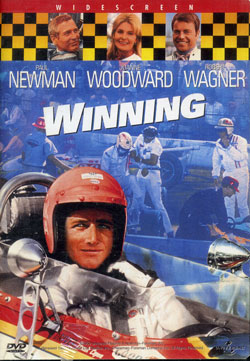|
|
|
Joyce says... We confess: this has long been one of our favorite racing movies if only so we get to see the brilliant Paul Newman at the top of his game, portraying the strong, silent type to perfection. The fact that there’s solid racing footage, other first-rate actors and a pretty believable story line, all adds up to a film far better than most that purport to bring racing to the screen. Winning was planned to be a made-for-TV flick at the time when television was churning out once-and-done movies at an incredible rate. But Newman had caught the racing bug and saw this film as an opportunity to combine work and play. Through his own production company, Winning was elevated to an A film level. Newman plays Frank Capua, a completely obsessed race driver who runs—and wins—in everything from stock cars and sports cars to Indy cars. Because a lot of drivers did cross-platform at that time, it was a believable possibility, although specialization was already finding its footing. But this was the era of Foyt, Andretti and Unser, as well as Allison and Yarbrough racing wherever they could, so the Capua character rings true. Nearing mid-life Newman falls hard and fast for Joanne Woodward. Unlike a lot of real-life movie couples, Newman and Woodward generate real heat on the screen. It’s neat to see Newman’s character fall for a mature—if drop-dead gorgeous—woman instead of one of the many young groupies available. But although in theory he is ready for family life, he isn’t actually ready to give up his obsession with hands-on race car preparation. Next thing he knows, he walks into the Speedway motel where his lonesome wife has taken up with his chief rival. An emotionally battered and brooding Capua (and nobody plays this better than Newman in his prime) manages to win the Indy 500, but realizes there has to be more than trophies and money. “I’m driving good, but my life is crap.” The movie works Capua back toward his wife, but doesn’t cop out in the end. It’s clear that Frank and Elora still have obstacles—but maybe, just maybe it will work out. The movie is just long enough for character development, although multiple viewings do nothing to endear us to a whiny 16-year-old played by Richard Thomas in his first movie role. But we were never wild about John Boy and the Waltons either. The racing sequences are good—even the green screen shots, but the most valuable racing aspect is a long, beautiful recorded sequence from the gates opening on race day at Indy until the green flag. Winning captured and froze on film a moment of genuine Americana. If your TV time is limited, put Winning at or near the top of your list of films to see. Not often has Hollywood been able to combine good racing and good story telling. But then, Hollywood didn’t listen to Paul Newman enough. Type of Racing: Indy car, stock car, sports car Tracks: Indianapolis Motor Speedway, Indianapolis Raceway Park, Riverside International Speedway (CA, now defunct), Road America (WI) Reel Racers: Paul Newman, Joanne Woodward, Richard Wagner, Richard Thomas Real Racers: Paul Newman, Bobby Unser (whose car was the model for Capua’s car), briefly other late 60s drivers including A.J. Foyt, Johnny Rutherford, and many mentioned on the race broadcast like Malloy, Grim, Kenyon, and McCluskey Year of Release: 1969 DVD Length: 123 minutes Approx. On-Track: 39 minutes (including 22 minutes segment on the 500) Color/B&W: Color Watch for: . . . They pour gasoline into a Can-Am prototype sports car—by way of a funnel. . . . “You gotta learn to trust something. Might as well be the seat of your pants,” says Capua. . . . Elora : “Even God took a rest on Sunday.”. Capua: “That’s the problem—I’m not God.” . . . The car owner is a jerk. Why is the car owner or a track promoter always the jerk in racing movies? Yes, there are plenty in real life, but not in proportion to what they are in reel life. . . . A perfectly preserved moment in racing history: Tony Hulman giving the command to start engines prior to the 500. . . . The big wreck at the start of the 500 is actual footage of the 1966 start. And if you watch closely, you can see A.J. Foyt climbing the fence, trying to get away from the mayhem. . . . One of the best movie lines ever sums up how consumed race drivers can get. After Capua takes an extra flat-out lap following the checkered flag, he’s asked why. And his response is, “I didn’t feel like stopping.” |
